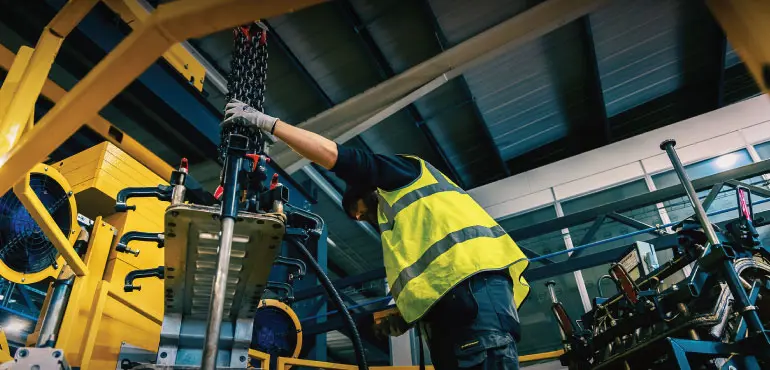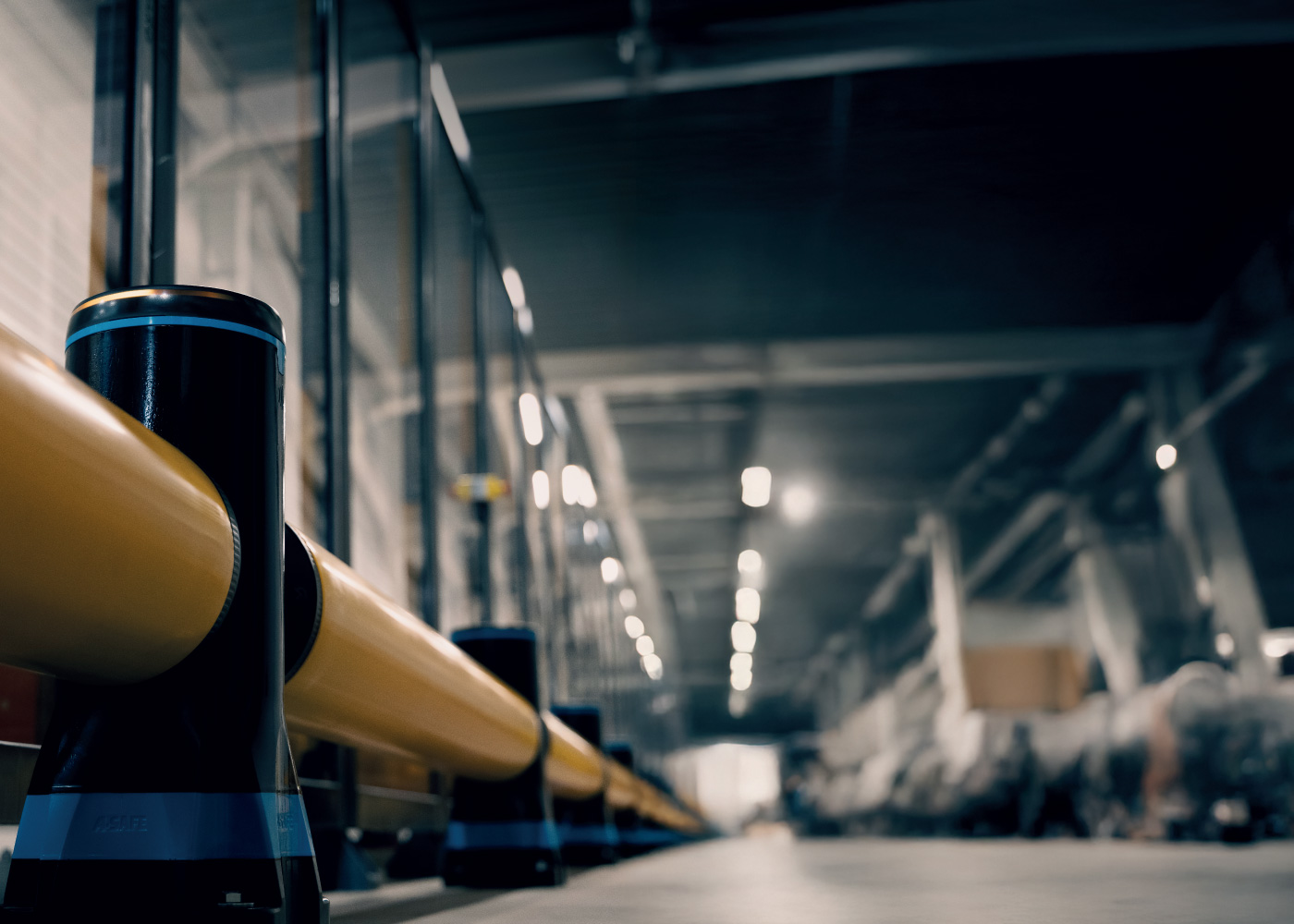
When you walk into a busy warehouse, distribution hub, manufacturing plant or airport terminal, chances are you’ll see barriers separating pedestrians from vehicles, protecting machinery from impact or shielding structural columns from damage. They may seem like simple pieces of equipment – just lines of posts and rails – but the engineering behind a high-performance safety barrier system is anything but simple.
At A-SAFE, we don’t just make barriers. We invented the world’s first industrial polymer safety barrier, and for over two decades we’ve refined the process that takes our systems from concept to installation, ensuring they perform day in, day out, in some of the most challenging industrial environments in the world.
Why Process Matters in Industrial Safety
Industrial safety is a field where compromise can have serious consequences. In a high-traffic warehouse, a forklift travelling at speed can cause significant damage to infrastructure – or worse, serious injury to staff.
This is why industrial safety barriers are not all created equal. Off-the-shelf alternatives – often made from low-grade steel or basic plastics – may look sturdy, but without the right design, materials and testing, their real-world performance can be unreliable.
A-SAFE’s approach is different. We build every barrier around real impact data, engineering it to dissipate energy safely while protecting the structures and people around it. The result: a system that delivers not just initial safety compliance, but consistent, proven protection for years to come.

Stage One – Designing for the Real World
Every A-SAFE system starts with the environment it is protecting. Our experts work closely with customers to understand the exact challenges of their site – traffic flow patterns, types of vehicles used, operating speeds, pedestrian routes, loading bay layouts and environmental factors like temperature fluctuations or moisture concerns.
We then move into the design phase, where our engineers use advanced CAD modelling and finite element analysis (FEA) to simulate impact forces. This allows us to test and optimize every dimension of the barrier before a single physical prototype is made.
Our products comply with global safety standards – including PAS 13 with TÜV Nord certification – ensuring that performance is independently validated. Whether it’s a crash barrier for loading bays or a pedestrian safety barrier in a warehouse, our systems are built to exceed industry benchmarks.
By designing for the exact demands of each site, we eliminate the “one-size-fits-all” compromises that often plague generic solutions.

Stage Two – Material Science that Changes the Game
When we first developed our polymer barriers, the industry was dominated by steel. Steel was strong, but rigid – when impacted, it often transfers impact forces into the floor, damage vehicles, and triggers costly repairs for the barrier and the surrounding environment.
Our polymer barriers changed that by using high-performance, energy-absorbing material that flexes under impact and returns to its original shape without permanent deformation. The internal structure of the polymer is engineered to dissipate energy through the barrier, rather than transferring it to the floor or surrounding structures.
To be clear, we don’t use off-the-shelf plastics. Our blends are designed in-house for specific applications, such as:
- Cold storage environments – flexible polymer barriers for cold-storage environments that remain impact-resistant even at sub-zero temperatures.
- High-visibility areas – high-visibility safety barriers that maintain color integrity even under heavy use and cleaning.
- Heavy vehicle protection – reinforced blends for protecting against heavier vehicle impacts.
The result is a barrier material that resists corrosion, never needs painting, and performs consistently over its entire lifespan.
Stage Three – Manufacturing Excellence
Design and material quality are only as good as the manufacturing process that brings them to life. At A-SAFE, we control the entire manufacturing process in our UK facilities, giving us complete oversight on quality.
Our production lines are optimized for precision and repeatability. Every component – from rails, to posts, to fixings – is produced to exacting tolerances, ensuring perfect fit and reliable performance.
A key part of our manufacturing philosophy is modularity. By designing barriers as modular systems, we make it possible to replace individual components if damaged, rather than replacing an entire run of barrier. This is central to our total cost of ownership promise – minimizing downtime and repair costs.
Further, our high-visibility UV-stable polymers ensure barriers remain easy to see in all lighting conditions. This isn’t just a cosmetic decision – clearly marked pathways and immediately recognizable no-go zones are a critical part of preventing incidents in high-traffic areas.

Stage Four – Testing Without Compromise
Testing is where the theory meets reality. We operate in-house impact testing facilities that replicate the forces and scenarios our barriers face in the real world.
Our barriers are subjected to simulated collisions from forklifts and other vehicles. These tests mimic different speeds, angles and impact points, while we digitally measure deflection, energy absorption and post-impact integrity, ensuring the barrier meets the specified performance rating.
Then, before any product is launched, we conduct pilot installations in live working environments, gathering real-world performance data and feedback.
We also work with TÜV Nord for independent verification of our testing methods, allowing customers to trust that our claims are impartially certified. This is why our barriers are trusted across multiple industrial sectors -- from logistics to manufacturing to aviation.
Stage Five – Installation & Integration
A great barrier is only as effective as its installation. Our safety experts conduct thorough site surveys, mapping out vehicle and pedestrian movements, identifying high-risk areas, and recommending the right combination of products – from loading bay pedestrian segregation barriers to protective bollards for structural columns.
Stage Six – Ongoing Support & Lifecycle Value
Our commitment doesn’t end when the barriers are installed. We provide ongoing support, including maintenance guidance, site audits, and system upgrades.
Because our barriers are modular and built from resilient materials, the need for full replacement is rare – and when repairs are needed, they’re quick and cost-effective. Many A-SAFE barriers installed over a decade ago are still in daily use, protecting facilities without loss of performance.
This longevity is where your real savings are realized. While cheaper steel or plastic barriers may require frequent repainting, repairs or replacement, A-SAFE systems deliver consistent protection with minimal maintenance over many years.
Innovation That Never Stops
Our research and development team continually gathers data from installations worldwide, using it to drive product evolution.
Recent innovations integrated IoT-enabled barriers that can record and transmit impact data, helping facilities identify high-risk areas and improve traffic management strategies. This new innovation will further increase ROI and reduce risk across facilities worldwide.

How A-SAFE Leads the Way
From the drawing board to the factory floor, every stage of our process is designed to produce barriers that don’t just meet safety standards – they set them. Our systems are trusted in the most demanding environments, from airport safety barriers protecting airside infrastructure, to defending assets and machinery in manufacturing facilities, to separating pedestrians from forklift traffic in busy warehouses.
We’re more than a manufacturer. We’re a partner in creating safer, more efficient, and more resilient workplaces.

Contact us today for a free site audit and discover the A-SAFE difference.

